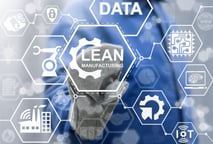-2.png?width=236&name=iot%20(1)-2.png) The use of IoT technologies in manufacturing is what simply constitutes Industrial IoT. The concept relies heavily on the use of big data technology and machine learning, making use of sensory & communication data to automate different processes. Without Industrial IoT monitoring, operations managers, plant managers and logistics coordinators throughout the manufacturing & distribution fields would lack the ability to make real-time decisions based on their assets’ health.
The use of IoT technologies in manufacturing is what simply constitutes Industrial IoT. The concept relies heavily on the use of big data technology and machine learning, making use of sensory & communication data to automate different processes. Without Industrial IoT monitoring, operations managers, plant managers and logistics coordinators throughout the manufacturing & distribution fields would lack the ability to make real-time decisions based on their assets’ health.
Sensors are a hotspot for data. All those sensors found on robots such as Automated Guided Vehicles collect data, but only a few manufacturers enable their machines to concretize it into something actionable & usable. This is a complaint that too surfaces too frequently as the world progresses towards Industry 4.0 revolution. Data which should turn into information is turning into Dark Data and bottlenecking the abilities to the system in place to accurately automate processes.
Data Impacting Safety
According to OSHA, each year there are 85 forklift fatalities and 34,899 serious injuries, where 42% of the fatalities are due to a tipping vehicle. The Industrial Truck Association states that the average life of a forklift is nine years, while it maintains a 90% chance of a serious accident throughout its life.
By using these statistics, policies such as fork-free zones can be set-up, decreasing if not eliminating injuries & fatalities. Similarly, plants can collect data from different injury-causing machinery, and develop policies that would essentially improve workplace safety and decrease financial losses due to insurance claims.
Vehicle Maintenance
Maintenance isn’t the most interesting topic in the world when it comes to AGVs or such mobile machinery. Few vendors want to discuss the costs that are brought by maintenance let alone the downtime that comes as a result of a breakdown. The fact of the matter is that vendors don’t include the downtime in their ROI calculations, which leads to unbalanced finances and trouble for plant managers.
Industrial IoT can help reduce such costs as sensors placed at key components within the AGV would provide early warnings before a failure occurs. This would allow the team to assess & address the issue at off-hours, leading to an uninterrupted work cycle.
Operational Efficiency
If a single vehicle stops on a high traffic area due to any fault, it could set off a ripple effect stopping all vehicles behind it. This essentially transforms a 15-minute stoppage into a 150 minute one for ten vehicles in the system. When an Industrial IoT monitoring solution is implemented, these types of errors are rectified beforehand.

Lean Manufacturing Perspective
A sensor suite based IIoT approach can be used to achieve best & most cost-savvy solutions within a plant. Having such a solution ensures that the system remains flexible and capable of handling complex workloads while retaining its cost-effeteness. This technology has been a gamechanger especially in the materials handling industry. AGVs are being equipped with a mechanism through which the software takes over all the controls, order generation and routing.
This means that plant managers would be able to eliminate all errors caused by manual interventions, receiving a stream of accurate information about the materials handling system in place. This would give the system automation functionalities as well as predictive modelling capabilities, bagging both short-term & long-term benefits for the plant & workspace.
Interested in learning more, connect with an ACD expert!
You may also be interested in reading:


